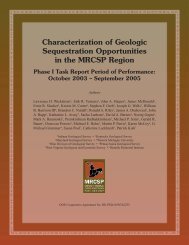Unraveling the stratigraphy of the Oriskany Sandstone: A necessity ...
Unraveling the stratigraphy of the Oriskany Sandstone: A necessity ...
Unraveling the stratigraphy of the Oriskany Sandstone: A necessity ...
Create successful ePaper yourself
Turn your PDF publications into a flip-book with our unique Google optimized e-Paper software.
Figure 4. (a) Secondary electron SEM images <strong>of</strong> syntaxial quartz overgrowths (Q) reducing intergranular porosity. Pressure solution<br />
pits on quartz grains are coated with illite. (b) Photomicrograph <strong>of</strong> porosity textures in <strong>the</strong> Doc play. Porosity types include moldic (M),<br />
oversized (O), and enlarged intergranular (I). Both images are from Core 2914, Mahoning County, Ohio.<br />
Petrophysical Evaluation<br />
Reservoir characteristics <strong>of</strong> <strong>the</strong> <strong>Oriskany</strong> <strong>Sandstone</strong><br />
within <strong>the</strong> Doc were evaluated using two whole rock<br />
cores and geophysical logs from 30 wells. The data indicate<br />
considerable variability in lithology, porosity,<br />
and permeability within <strong>the</strong> play, but <strong>the</strong> nor<strong>the</strong>rn half<br />
<strong>of</strong> <strong>the</strong> play and near <strong>the</strong> updip permeability pinch-out<br />
boundary to <strong>the</strong> west represents <strong>the</strong> <strong>Oriskany</strong> <strong>Sandstone</strong><br />
with <strong>the</strong> most favorable characteristics observed<br />
in <strong>the</strong> basin.<br />
Porosity values for <strong>the</strong> Doc play are <strong>the</strong> highest observed<br />
in this study. Thirty neutron- and density-porosity<br />
logs from Ohio, West Virginia, and Pennsylvania were<br />
evaluated, and <strong>the</strong> average porosity was determined to<br />
be 5.3%. The minimum porosity, 0.73%, was calculated<br />
from a well in McDowell County, West Virginia, and a<br />
maximum porosity <strong>of</strong> 12.8% was calculated in a well<br />
from Beaver County, Pennsylvania. Porosity and permeability<br />
values from <strong>the</strong> Jones and McLaughlin Steel<br />
Corporation 1 well in Beaver County, Pennsylvania,<br />
and an additional core analysis from <strong>the</strong> T.D. Herren<br />
2 well (Core 2914), Mahoning County, Ohio, were included<br />
in this study. Thin sections from multiple depths<br />
throughout <strong>the</strong> <strong>Oriskany</strong> interval in Core 2914 were<br />
also analyzed.<br />
Core and Petrographic Data<br />
The Jones and McLaughlin Steel Corporation 1 well<br />
was drilled in 1960 for wastewater disposal, and <strong>the</strong><br />
Onondaga through <strong>Oriskany</strong> interval was cored and<br />
192 Sequestration Potential <strong>of</strong> <strong>the</strong> <strong>Oriskany</strong> <strong>Sandstone</strong><br />
sampled for porosity and permeability analyses. Twentytwo<br />
samples, from randomly selected depths, starting at<br />
5388 ft (1642 m), <strong>the</strong> top <strong>of</strong> <strong>the</strong> <strong>Oriskany</strong> <strong>Sandstone</strong> to<br />
5426 ft (1654 m), and <strong>the</strong> top <strong>of</strong> <strong>the</strong> Helderberg Limestone,<br />
were analyzed for porosity and permeability by<br />
<strong>the</strong> Pennsylvania Geological Survey. The average porosity<br />
in this zone is 3.9%, with a maximum value <strong>of</strong> 6.4%<br />
at 5410 ft (1650 m) and a minimum porosity <strong>of</strong> 0.02%<br />
at 5389 ft (1643 m). Permeability averages 1.6 md, with<br />
values ranging from 0.2 to 4.6 md.<br />
Core 2914 is from <strong>the</strong> T.D. Herren 2 well in Mahoning<br />
County, Ohio. The well was drilled in 1962 and<br />
produces from <strong>the</strong> <strong>Oriskany</strong> and Medina Group sandstones.<br />
Wireline logs reveal that <strong>the</strong> <strong>Oriskany</strong> occurs<br />
between 3317 and 3332 ft (1011 and 1016 m). The <strong>Oriskany</strong><br />
was cored from 3324 to 3337 ft (1013 to 1017 m).<br />
Seven samples were collected at various depths along<br />
this cored interval.<br />
At this location, <strong>the</strong> <strong>Oriskany</strong> is primarily a quartz<br />
arenite with interbedded sandy limestones and calcareous<br />
sandstones. The quartz arenites consist <strong>of</strong> fine to medium<br />
subrounded quartz grains with minor amounts <strong>of</strong><br />
intergranular calcite cement and quartz overgrowth cement.<br />
Rock fragments are also common in <strong>the</strong>se quartz<br />
arenites. The calcareous units are darker in color because<br />
<strong>of</strong> increased argillaceous material. Argillaceous laminations,<br />
stylolites, and some minor fractures occur in <strong>the</strong><br />
carbonate-rich units. Fossil assemblages are dominated<br />
by brachiopods, echinoderms, and mollusks. Calcite<br />
and quartz cements are observed in <strong>the</strong> quartz arenites.<br />
Quartz cementation occurs as syntaxial overgrowths<br />
(Figure 4a), and calcite cements have primarily blocky





